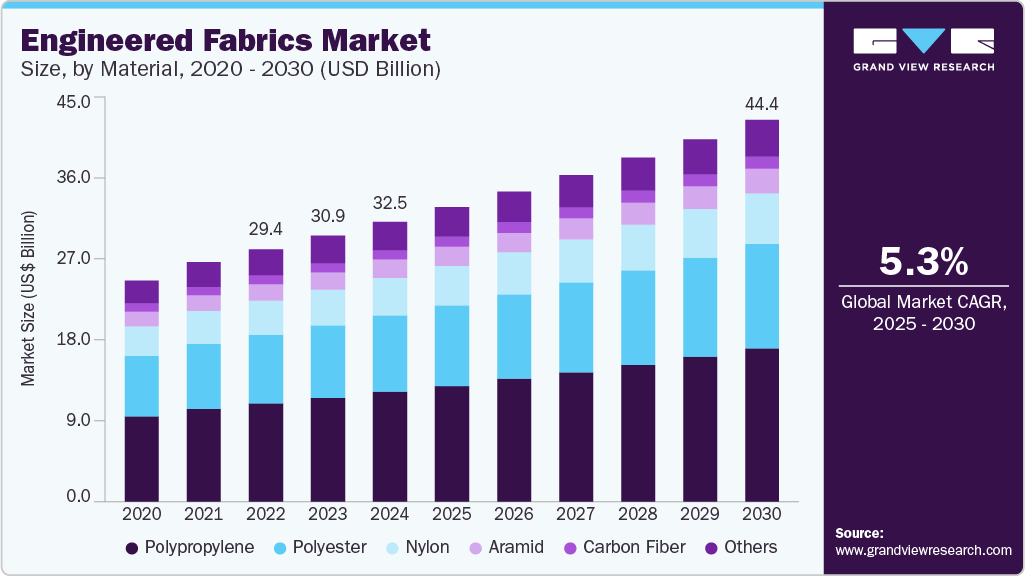-
Noticias Feed
- EXPLORE
-
Páginas
-
Grupos
-
Eventos
-
Blogs
Engineered Fabrics Market Supported by Rapid Urbanization and Infrastructure

The global engineered fabrics market size was estimated at USD 32.54 billion in 2024 and is projected to reach USD 44.36 billion by 2030, expanding at a CAGR of 5.3% from 2025 to 2030. This growth is largely driven by the versatile applications of engineered fabrics across diverse industries such as healthcare, automotive, construction, and personal care.
Engineered fabrics are valued for their advanced properties including high strength, durability, breathability, and resistance to chemicals and moisture. These attributes make them highly suitable for use in medical textiles, geotextiles, filtration systems, and hygiene products.
Environmental concerns are also fueling the development and adoption of sustainable and biodegradable engineered fabrics, further boosting their usage across both industrial and consumer markets. The increasing demand in healthcare is evident through the rising need for high-performance medical textiles such as surgical gowns, masks, and wound dressings, especially in the post-COVID-19 era. Similarly, in automotive and construction sectors, engineered fabrics aid in lightweighting, insulation, and improved durability—key elements aligned with global trends toward energy efficiency and sustainability. Rapid urbanization, infrastructure development, and consumer preference for durable and hygienic materials also continue to drive market expansion.
Innovation remains central to the evolution of engineered fabrics, with efforts focused on enhancing functionality while ensuring environmental responsibility. Technologies such as nanotechnology and 3D weaving are being used to improve properties like strength, thermal regulation, and antimicrobial resistance. The emergence of smart textiles—engineered fabrics embedded with sensors or responsive materials—offers promising applications in healthcare monitoring and wearable tech. Additionally, growing investments in eco-friendly materials like biodegradable polymers and recycled fibers reflect the industry's response to regulatory and sustainability demands, ushering in the next generation of high-performance, sustainable engineered fabrics.
Order a free sample PDF of the Engineered Fabrics Market Intelligence Study, published by Grand View Research.
Key Market Trends & Insights
- Asia Pacific held the largest market share of approximately 37.9% in 2024.
- China leads within Asia Pacific and remains a global leader in engineered fabric production.
- By material, polypropylene was the top segment, accounting for 39.2% of the total revenue in 2024.
- By end-use, the healthcare segment dominated with a 33.4% revenue share in 2024.
Market Size & Forecast
- 2024 Market Size: USD 32.54 Billion
- 2030 Projected Market Size: USD 44.36 Billion
- CAGR (2025–2030): 5.3%
- Leading Region: Asia Pacific
Key Engineered Fabrics Company Insights
- DuPont: A global leader offering Tyvek and Sontara, known for durability, breathability, and protective performance.
- Freudenberg Performance Materials: A division of Freudenberg Group, supplying fabrics for automotive, medical, and construction uses with a focus on sustainability.
- Kimberly-Clark Corporation: Produces nonwoven fabrics for hygiene and medical applications, emphasizing comfort and safety.
- Ahlstrom: Specializes in sustainable, fiber-based materials for various applications including medical, filtration, and packaging.
Key Companies in the Engineered Fabrics Market:
- DuPont
- Freudenberg Performance Materials
- Kimberly-Clark Corporation
- Ahlstrom
- Berry Global Inc.
- Toray Industries, Inc.
- MEHLER ENGINEERED PRODUCTS GMBH
- Emtexglobal USA
- Johns Manville
- Avgol Nonwovens
Explore Horizon Databook – The world's most expansive market intelligence platform developed by Grand View Research.
Conclusion
The engineered fabrics market is undergoing robust growth fueled by expanding applications, rising demand for high-performance and sustainable solutions, and continuous innovation. As industries increasingly prioritize efficiency, functionality, and environmental responsibility, engineered fabrics will play an essential role in meeting these evolving demands. Strategic advancements and the adoption of smart and eco-friendly materials are expected to shape the future of this dynamic market.
- Art
- Causes
- Crafts
- Dance
- Drinks
- Film
- Fitness
- Food
- Juegos
- Gardening
- Health
- Home
- Literature
- Music
- Networking
- Other
- Party
- Religion
- Shopping
- Sports
- Theater
- Wellness


